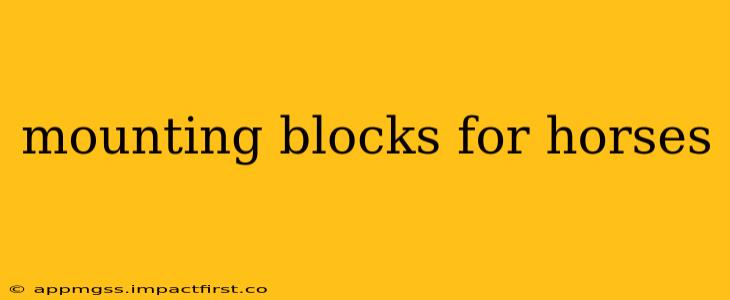Choosing the right mounting block for your horse and your needs can significantly improve your riding experience and safety. This guide explores various types, sizes, and considerations to help you select the perfect mounting aid.
What are Mounting Blocks for Horses?
Mounting blocks are elevated platforms designed to assist riders, particularly those with mobility challenges or those mounting larger horses. They provide a safe and comfortable step up into the saddle, reducing the strain on both rider and horse. A good mounting block can make mounting and dismounting a smoother, safer process.
What are the Different Types of Mounting Blocks?
Several types of mounting blocks cater to different preferences and needs:
Wooden Mounting Blocks:
These are the most traditional and commonly used. They offer a stable and sturdy platform, often made from durable hardwoods. Wooden blocks come in various heights and styles, from simple rectangular blocks to those with added features like handrails or non-slip surfaces.
Portable Mounting Blocks:
Ideal for traveling or use at various locations, these are lightweight and easy to transport. They're often made from lighter materials like plastic or aluminum, but still provide sufficient support.
Adjustable Height Mounting Blocks:
Offering versatility, adjustable blocks allow you to customize the height to suit different riders and horses. This feature ensures optimal comfort and safety for everyone.
Mounting Blocks with Handrails:
For added security, especially for less experienced riders or those with balance issues, mounting blocks with integrated handrails provide extra support during mounting and dismounting.
What Height Mounting Block Should I Choose?
The ideal height depends on several factors:
-
Rider's Height and Leg Length: A shorter rider will need a lower block, while a taller rider might need a higher one. The goal is to have a comfortable step-up without overextending or straining.
-
Horse's Height: Taller horses will naturally require a slightly higher mounting block to maintain a safe and balanced mounting position.
-
Rider's Fitness Level and Mobility: Riders with mobility limitations might benefit from a lower block for easier access.
How Do I Use a Mounting Block Safely?
Safe mounting block usage is crucial for both rider and horse safety:
- Stable Positioning: Ensure the block is placed on level ground, and firmly positioned before mounting.
- Controlled Movements: Mount and dismount smoothly and deliberately, avoiding sudden movements that could startle your horse.
- Proper Foot Placement: Place your foot securely on the block before mounting, avoiding slips.
- Horse's Behavior: Always be aware of your horse's demeanor, and ensure they are calm and receptive before mounting.
What Materials are Mounting Blocks Made From?
Mounting blocks are commonly made from wood, plastic, and metal (aluminum). Wood offers stability and durability, while plastic is lightweight and easy to clean. Metal offers strength and durability, but can be heavier than other options.
How Much Do Mounting Blocks Cost?
Prices vary depending on materials, features, and brand. You can find basic wooden blocks for relatively low costs, while adjustable or more feature-rich blocks may be more expensive.
Where Can I Buy a Mounting Block?
Mounting blocks are available from a variety of equestrian suppliers, both online and in physical stores. Many tack shops and farm supply stores carry a selection of mounting blocks.
This comprehensive guide provides a solid foundation for choosing the right mounting block. Remember to prioritize safety and comfort when making your selection. Proper use and careful consideration of your individual needs will ensure a safer and more enjoyable riding experience.
